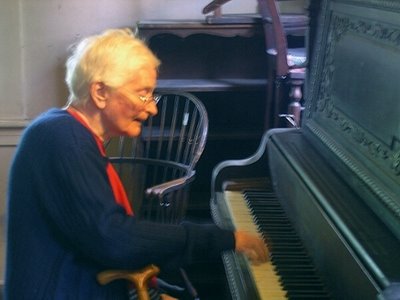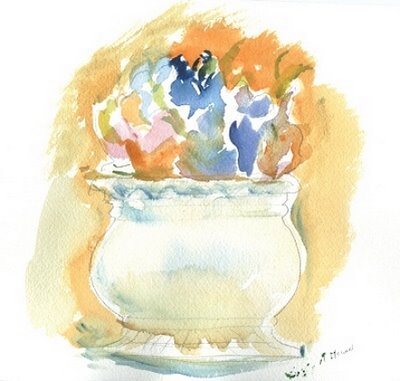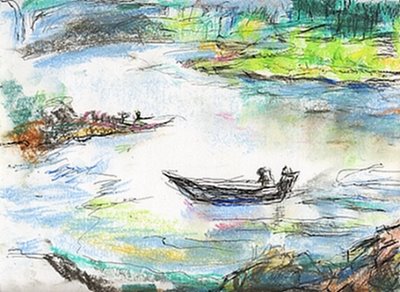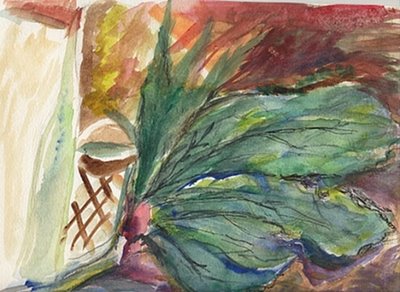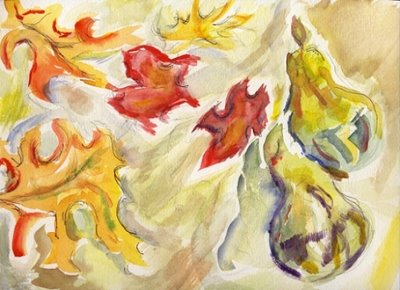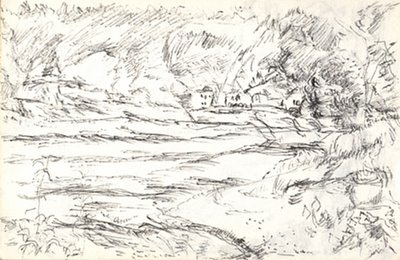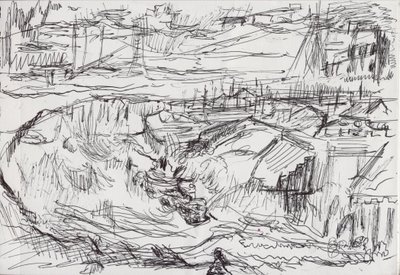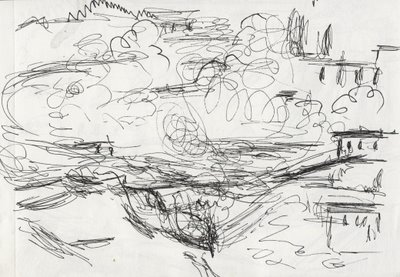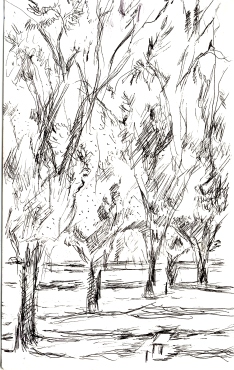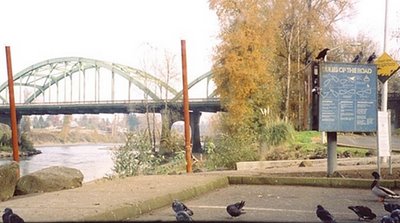Preface and Chapter 10: May 2004
PREFACE TO MOM THE ARTIST, PART TWO
This blog is Part Two of two. The first blog, "Mom the Artist," should be read first and is at http//momtheartist.blogspot.com. It presents my mother Nancy Howard's artwork, in images and commentary, up until April of 2004. These earlier works, most done when she was in her 70's, are full of sun, magic, and vitality, and I highly recommend them to you at the earlier blog.
This current blog continues the story for the last one and a half years of her life, ages 85-87, when her health was declining. But she was at least as prolific as before. Her art took highly original if sometimes darker turns, which I am privileged to share with you. These latter works, some of them, are Mom's gift to the world, as an art historian said at Mom's memorial service.
Read the first blog for instructions on how to navigate these blogs. Remember, you can get a larger view of the images that are wider than they are tall by clicking on the image. The artworks themselves, as opposed to the images, are mostly of two sizes. When Mom did her "pen and inks" outside, she almost always used 5.5 by 8.5 inch sketchbooks. The only exceptions are in Chapter 19, when she used a 9 by 12 inch sketchbook. For her work indoors, watercolors and acrylics, she used mostly 8.5 by 11 or 9 by 12 inch sketchbooks. The only exception here is the acrylic in Chapter 16, which was 10 by 14.
In my text, the numbers and letters in parentheses are for reference purposes. The numbers originally corresponded to the chapter numbers, but then for the blog I had to amalgamate some chapters, as explained in the first blog. I saw no reason to renumber everything.
CHAPTER 10: MAY 2004
On Easter Sunday, 2004, my sister Cathy and her husband Karl took Mom around Mt. Hood on a drive. On the way down she became disoriented and confused. Her speech stopped making sense. They took her to the hospital in Hood River, where they said she had had a stroke. A CT scan or two later, the nature of the stroke was clearer: it affected the left hemisphere, and mainly the parts of the brain involving speech. At the least, Mom’s verbal communication ability, both to and from others, was impaired.
Moreover, one of her carotid arteries—the main arteries in the neck—was 100% blocked, and the other 80%. She underwent an operation to clear the partially blocked one—it was too late for the other. Afterwards, she recovered in the Marquis Care Center in Oregon City. Almost immediately she wanted her sketchbook and a pen. She was going to sketch the portraits of the people she encountered there. She gave many of the originals to the people she sketched, but I made copies on the care center’s copy machine.
The first one (12a) is of Al, a stroke victim who lived at the facility. He knew Mom’s husband John from the paper mill where they both had worked. His wife Bernice, (12b) visited him every day for a few hours. She was full of energy and life, in contrast to her husband, who was either depressed or less responsive to his environment due to the stroke. The sketch of the two together (12c) makes the contrast clear.
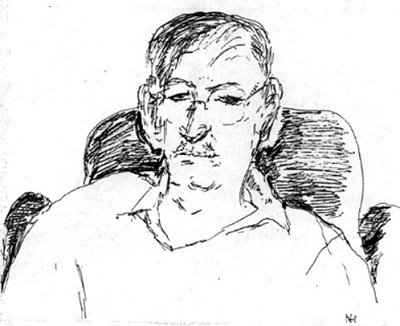


Another sketch of Bernice has her in the garden, by the fence, with her back to us—-a pose characteristic of Mom’s style even before the stroke (12d).
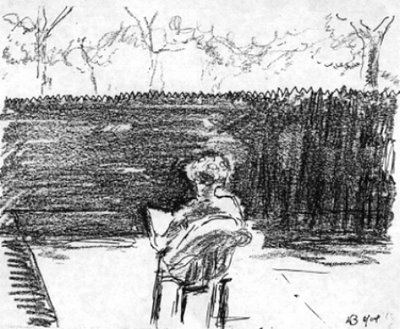
There was a truck driver named Jim in the facility, recovering from a burst appendix. 2000 miles from his Detroit home, he looked lonely and impatient to get back. When he got the original of this sketch (12e) he brightened a little:

Mom drew other long-term residents (12f-g). She was not after a pretty picture. She was after truth, a truth she was fearful of becoming herself. In the slides so far in this chapter, have you ever seen this subject taken up in this way before?
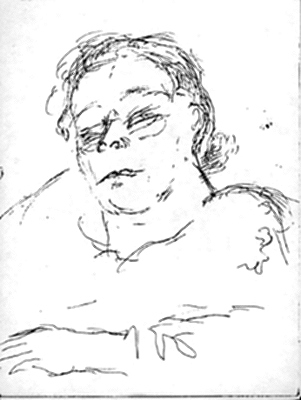

I seem to detect not merely a blank or downcast look in these portraits, but a shining spirit underneath. Mom was not just drawing appearances, but the soul.
She also sketched her speech therapist, a perky young woman who visited two or three times a week (12h):
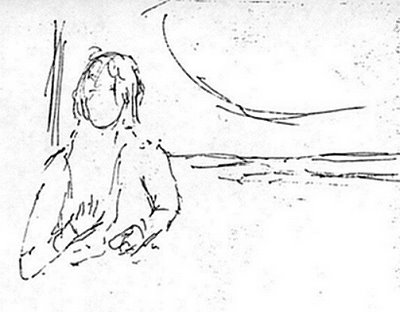
For some reason, Mom drew her without a face. Perhaps she couldn't see the young woman's soul. Mom was not fond of the employees at Marquis Care Center. For one thing, the aides kept giving her “soft” meals even after the dietician changed the order to “mechanical soft,” a more appetizing proposition. They corrected themselves when family was there to support her protest.
Mom’s sketching turned away from people—a depressing and scary subject at this point—to other living things. There was a dog named Mitch. I don’t know whose it was, but he was very cute and vied with Jim for the couch (12i):
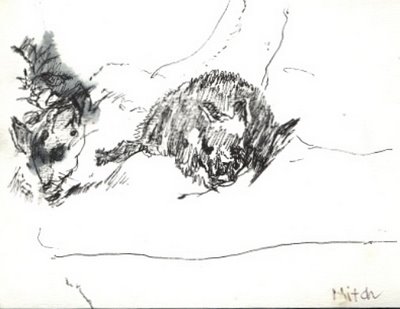
Then there were the flowers that people sent to her room, which she sketched in a Matisse-like way (12j):

There was also the garden, full of life (12k):

One plant was particularly attractive; its leaves shot upwards and out like the jets of a fountain, full of the vitality Mom wanted to get back (12l):
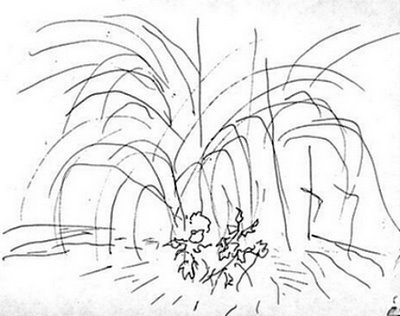
To give an idea what she was drawing, here is a photo of my wife Ela and me in the garden, taken by Mom (12m):

In her second week at the Marquis, Mom felt up to trying color. Sketching the garden in color was a real picker-upper. Again the focus is the larger-than-life fountain-like plant, now flaming with inner vitality like a bonfire (12n-o).

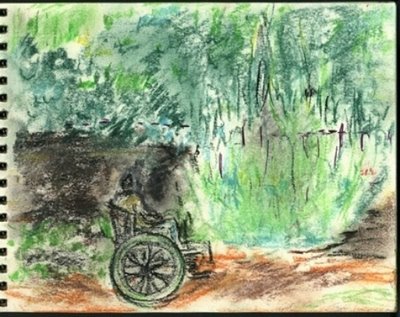
And of course people still brought her flowers (12p):

By the end of the second week, Mom was ready to go, although not yet in a position to live independently. I have a photo of her toward the end of that second week, hopeful but also somewhat scared of the future (12q):
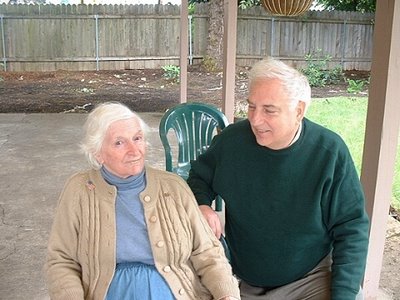
This blog is Part Two of two. The first blog, "Mom the Artist," should be read first and is at http//momtheartist.blogspot.com. It presents my mother Nancy Howard's artwork, in images and commentary, up until April of 2004. These earlier works, most done when she was in her 70's, are full of sun, magic, and vitality, and I highly recommend them to you at the earlier blog.
This current blog continues the story for the last one and a half years of her life, ages 85-87, when her health was declining. But she was at least as prolific as before. Her art took highly original if sometimes darker turns, which I am privileged to share with you. These latter works, some of them, are Mom's gift to the world, as an art historian said at Mom's memorial service.
Read the first blog for instructions on how to navigate these blogs. Remember, you can get a larger view of the images that are wider than they are tall by clicking on the image. The artworks themselves, as opposed to the images, are mostly of two sizes. When Mom did her "pen and inks" outside, she almost always used 5.5 by 8.5 inch sketchbooks. The only exceptions are in Chapter 19, when she used a 9 by 12 inch sketchbook. For her work indoors, watercolors and acrylics, she used mostly 8.5 by 11 or 9 by 12 inch sketchbooks. The only exception here is the acrylic in Chapter 16, which was 10 by 14.
In my text, the numbers and letters in parentheses are for reference purposes. The numbers originally corresponded to the chapter numbers, but then for the blog I had to amalgamate some chapters, as explained in the first blog. I saw no reason to renumber everything.
CHAPTER 10: MAY 2004
On Easter Sunday, 2004, my sister Cathy and her husband Karl took Mom around Mt. Hood on a drive. On the way down she became disoriented and confused. Her speech stopped making sense. They took her to the hospital in Hood River, where they said she had had a stroke. A CT scan or two later, the nature of the stroke was clearer: it affected the left hemisphere, and mainly the parts of the brain involving speech. At the least, Mom’s verbal communication ability, both to and from others, was impaired.
Moreover, one of her carotid arteries—the main arteries in the neck—was 100% blocked, and the other 80%. She underwent an operation to clear the partially blocked one—it was too late for the other. Afterwards, she recovered in the Marquis Care Center in Oregon City. Almost immediately she wanted her sketchbook and a pen. She was going to sketch the portraits of the people she encountered there. She gave many of the originals to the people she sketched, but I made copies on the care center’s copy machine.
The first one (12a) is of Al, a stroke victim who lived at the facility. He knew Mom’s husband John from the paper mill where they both had worked. His wife Bernice, (12b) visited him every day for a few hours. She was full of energy and life, in contrast to her husband, who was either depressed or less responsive to his environment due to the stroke. The sketch of the two together (12c) makes the contrast clear.



Another sketch of Bernice has her in the garden, by the fence, with her back to us—-a pose characteristic of Mom’s style even before the stroke (12d).

There was a truck driver named Jim in the facility, recovering from a burst appendix. 2000 miles from his Detroit home, he looked lonely and impatient to get back. When he got the original of this sketch (12e) he brightened a little:

Mom drew other long-term residents (12f-g). She was not after a pretty picture. She was after truth, a truth she was fearful of becoming herself. In the slides so far in this chapter, have you ever seen this subject taken up in this way before?


I seem to detect not merely a blank or downcast look in these portraits, but a shining spirit underneath. Mom was not just drawing appearances, but the soul.
She also sketched her speech therapist, a perky young woman who visited two or three times a week (12h):

For some reason, Mom drew her without a face. Perhaps she couldn't see the young woman's soul. Mom was not fond of the employees at Marquis Care Center. For one thing, the aides kept giving her “soft” meals even after the dietician changed the order to “mechanical soft,” a more appetizing proposition. They corrected themselves when family was there to support her protest.
Mom’s sketching turned away from people—a depressing and scary subject at this point—to other living things. There was a dog named Mitch. I don’t know whose it was, but he was very cute and vied with Jim for the couch (12i):

Then there were the flowers that people sent to her room, which she sketched in a Matisse-like way (12j):

There was also the garden, full of life (12k):

One plant was particularly attractive; its leaves shot upwards and out like the jets of a fountain, full of the vitality Mom wanted to get back (12l):

To give an idea what she was drawing, here is a photo of my wife Ela and me in the garden, taken by Mom (12m):

In her second week at the Marquis, Mom felt up to trying color. Sketching the garden in color was a real picker-upper. Again the focus is the larger-than-life fountain-like plant, now flaming with inner vitality like a bonfire (12n-o).


And of course people still brought her flowers (12p):

By the end of the second week, Mom was ready to go, although not yet in a position to live independently. I have a photo of her toward the end of that second week, hopeful but also somewhat scared of the future (12q):

